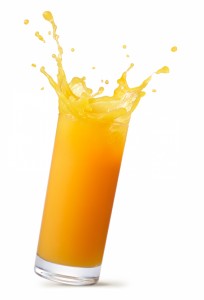Fruit juice
Many people think fruit juice is a healthy drink that can contribute to the recommended serves of fruit per day. However, nutritionally speaking it doesn’t come close to the nutritional value of eating a piece of fruit.
So, what’s the difference?
A piece of fruit provides essential vitamins and minerals and because of its high-fibre content can satisfy hunger for longer when you eat it. When you drink a glass of fruit juice, you get all the energy (kilojoules) from the natural sugars in the fruit, some of the vitamins and very little of the fibre and nutrients from the skin and flesh. Exposure to heat and light when the juice is extracted from fruit leads to a loss of vitamins and minerals – all of which you benefit from when you eat a piece of fruit.
How does this affect weight gain?
Think about when you drink a glass of fruit juice, how much juice do you pour? One serve of fruit from juice is only 125ml. The average glass is 250ml, or even more. That means for every glass you drink, you are consuming the equivalent kilojoules to at least two pieces of fruit, but without the added benefits of the fibre, vitamins and minerals. So when you pour instead of bite, think how many pieces of fruit you are having in a glass and be mindful. Its easy to over drink juice which can lead to weight gain if the energy (kilojoules) is not being burnt off through physical activity.
What about juice that claims “no-added sugar”?
Sugar provides nothing else other than energy (kilojoules). Foods containing added sugars are recommended to be occasionally eaten and in small amounts. Foods naturally high in sugar such as fruit and dairy provide other nutrients from the other parts of the food. In the case of fruit, the predominant natural sugar that occurs is fructose, as well as a combination of other sugars such as glucose and sucrose. The Australian Guide to Healthy Eating recommends we eat two pieces of fruit every day for the antioxidants, vitamins, minerals and fibre – not the sugars. The sugar in fruit juices comes directly from juicing the fruit. When selecting a fruit juice, choose one with the highest percentage juice to ensure that is all you are getting, no added sugars or flavourings. Fruit drinks, as opposed to fruit juices, have much less fruit juice in them as they only need to contain 5mL of fruit juice per 100 ml to be called a fruit drink, except if it is a passion fruit drink, which only requires 3.5mL of juice per 100mL. The rest of the content is made up of water, added sugar and/or flavouring.
What are the other health issues?
A significant concern of consuming fruit juice can be dental decay. Fruit naturally contains high amounts of vitamin C – also known as ascorbic acid, which can erode teeth enamel. The high concentration of sugar can also lead to dental decay if dental hygiene habits are poor. Lingering sugar on the teeth creates an ideal environment for bacteria to eat away at tooth enamel. For this reason, the Australian Dental Association recommends that parents limit their child’s fruit juice intake and dilute it down with tap water to a 50:50 mix.
So, what should my child be drinking?
The Healthy Kids Association recommends tap water be the first drink of choice second to reduced-fat milk, with one small glass (125ml) of 99% fruit juice being allowed daily for all ages.







